|
This month, I once again stray from the
strict topic of corals. Some projects I had started recently,
along with several posts during an extremely busy month on
The Coral Forum, gave me the idea for this column. Many years
ago, I wrote a pseudo-article for the old AOL Forum called
"The Reef According to Eric." It was a very popular
little piece, and I detailed what I felt were, at the time,
aspects of a successful reef aquarium. I updated it many times
over the years, but eventually it seemed unnecessary to continue
offering it because the information had become so widely known.
The present article will be based on the
"how-to" concept, but with a different tack. I offer
here some of my personal tips and tricks and suggestions for
reef aquarists in 2004. What I write is certainly not to be
taken as gospel, but rather as personal experience that I
hope will be valuable.
A Big Deal: The Acclimation of Corals (and
Other Things)
Frequently, I am asked about corals that
change in appearance or look poorly after being purchased
and introduced into a home aquarium. In particular, a coral
that looked healthy in the store is introduced into an aquarium,
often with what appear to be better conditions that those
in which it had previously resided, only to look in a remarkably
less healthy condition soon thereafter.
One of the questions I often ask in response
to such questions is, "Did you test the bag water or
the store water?" The answer is usually, "No."
Testing the bagged water is a lesson I learned quite a while
ago after enduring far too many inexplicable losses of otherwise
apparently healthy livestock. Most aquarists are familiar
with drip-type acclimations. The "old-timers rule,"
based on acclimating freshwater fish, is to make sure the
temperature and pH are slowly matched between the bag and
the tank, usually through the introduction of small amounts
of tank water to the shipping bag. This practice seems fairly
common with aquarists whose shipments arrive at the door in
a box, and somewhat less common with livestock brought directly
home from a local store.
Unfortunately, temperature and pH are not
always the whole story, and this is especially true of marine
invertebrates. To use corals as an example, I think most people
have experienced the relatively long period of time it takes
for the average coral to "open up" or acclimate.
For some, it may be a period of minutes while for others it
may ultimately take months. This "period of adjustment"
is a normal biological response of an organism to a new environment
and the changes that take place may be truly staggering in
terms of number and complexity. Most of the changes are unseen,
but are occurring nonetheless.
Acute changes may be obvious. For example,
if an animal is plunged from saltwater into freshwater, the
changes are usually fast and visually obvious in those animals
that manifest behavioral responses. To use a coral example
again, the rapid withdrawal of polyps is usually the first
response to adverse stimuli. Most aquarists would probably
agree that moving a coral from water that is 76oF, with 30ppm
of nitrate, a specific gravity of 1.021, 40 watts of fluorescent
light, and virtually no water flow to a tank at 82oF, a specific
gravity of 1.025, unmeasurable nitrates, 400 watts of metal
halide lamps, and strong water flow would be a stressful event
that would (and often does) lead to mortality of the organism,
despite the fact that the latter conditions may be more natural
and better for the long-term health of the organism. However,
behavioral responses under such conditions may include self-shading
by polyp contraction, sloughing of mucus tunics, catatonia,
and death.
What may (or may not) be surprising is
that many facilities that sell or trade in livestock have
water quality that is less than ideal. The animal or plant
purchased at any given time may or may not have spent some
considerable acclimatory period in another tank prior to it
being purchased by the aquarist. Upon arrival at that same
facility, the organism may have looked very similar to the
state the aquarist finds it in upon introduction to their
tank. Just because something looks healthy, does not in any
way suggest that it is healthy. A fish that eats at the store
may be eating because it is starving. A coral that is highly
expanded at the store may be expanded because it is starving
or receiving suboptimal light.
The point here, if it is not already obvious,
is that it only makes sense to know what the water quality
is from the tank or habitat from whence the organism came.
When I collect corals from the wild, I make it a practice
to either make subjective notes or directly measure water
parameters in order to most accurately reproduce those conditions
in an aquarium. When I get a shipment from anywhere, or when
I purchase livestock from stores, I ask the facility what
their water parameters are, or I directly measure water samples
from the packing container or bag.
There are two schools of thought regarding
acclimation; to remove an organism as quickly as possible
from the poor water conditions and into a tank with presumably
good water conditions, treating the shipping event as a temporary
acute stress; or to proceed in diligent, careful and slow
acclimations in order to pamper an organism through a shipping
or transient holding location, treating the event as a chronic
stress or an acute stress to which another rapid change is
intolerable. The choice of which method to utilize unfortunately
depends on the circumstances and the tolerance of the organism.
In general, I feel that if something has been in a store for
more than a few days and the water quality is significantly
different from the aquarists' tank, it has undergone some
degree of acclimation and can tolerate, and should likely
undergo, a longer more careful acclimation. If the store's
water is very similar to that in the destination tank and
the organism has been in holding or transit for less than
a day, a more rapid transfer to the tank might be preferable.
Things to Own
Over the years, I have bought, sold, tried,
accumulated, and disposed of a great deal of supplies and
equipment. Periodically, I find my closet and garage overflowing
with broken, unused, used, and useless parts and devices.
Unfortunately, most of the broken and useless things are aquarium
equipment. I have found a disconcertingly short lifespan for
most things produced by the aquarium trade. I have also found
that most of the really useful things I have for aquariums,
and which generally seem to last longer, are not strictly
designed for the aquarist. Most people probably have some
experience with this; it seems a trip to virtually any store
from the supermarket to eBay presents a smorgasbord of potentially
useful items for an aquarium! The following is a list of some
items that I feel are useful or even indispensable in keeping
reef aquaria.
Stereo or Dissecting Microscope
Honestly, most of the action and interest
happening in reef tanks is too small to see - or at least
see clearly. I really can't begin to express the worlds of
wonder that will open to aquarists with the use of a microscope.
To use a compound light microscope requires some degree of
experience, and also one generally needs some specialized
knowledge to appreciate higher magnification of most things.
However, a dissecting microscope is easy to use, practical,
and can be appreciated by even those without specific interests.
In particular, most aquarists are curious
to know the answer to the general question, "What is
it?" Identification of most things in the tank, from
corals to algae to worms and crabs, generally requires the
use of magnification. At the very least, magnification can
allow for the description of those things required for others
to answer the question, "What is it?" It can also
help the aquarist to determine, in some cases, reasons for
mortality or other problems in the tank.
PAR or Lux Meter
The typical reef aquarist spends hundreds
to thousands of dollars on lighting for their aquarium. Countless
hours of Internet forum, website, and catalog perusal are
spent determining lighting needs. Much of the interest and
concern is of relatively low consequence, and this is especially
the case when one really has no idea of light levels in one's
own aquarium. I am amazed how people will spend upwards of
$120.00 on a bulb, and hundreds of dollars on nonessential
equipment, but will not purchase or have even considered the
purchase of simple devices to measure light.
To be sure, lighting is a critical component
of most reef aquarium systems. It is equally critical to know
how much light is in the tank. There are now relatively inexpensive
devices available to directly measure photosynthetically active
radiation (PAR), and there are certainly very inexpensive
devices for measuring irradiance (lux). For half the price
of a 20000K HID bulb, a simple lux meter can be purchased
and used to determine light values in tanks, of various bulbs,
and how their output changes over time. There are, of course,
many differences in cost and quality of these light-measuring
devices, but even a $50.00 lux meter provides some real measurement
of light levels in aquariums. This, to me, is an essential
purchase for anyone concerned with reef lighting.
A lux meter is an inexpensive device to measure light levels.
Refractometer
Having and using a refractometer is a no-brainer.
For years, aquarists have been offered and then lamented the
miserably inaccurate products available at low cost to measure
what is arguably the most basic and important parameter in
reef aquaria - salinity. While many organisms can manage relatively
short periods of salinity change, prolonged exposure to sub-optimal
salinity is literally a killer. I cannot count the number
of problems that have befallen others and myself through inadvertent,
unrecognized, accidental, or lackadaisical carelessness in
salinity measurements.
I think many people are probably aware
of the poor accuracy, especially over time, of plastic swing
arm-type hydrometers. Many floating glass hydrometers are
either cheap and inaccurate, or are expensive and accurate
but calibrated at temperatures far from those where reef tanks
are kept (requiring inconvenient and possibly inaccurate scaling
techniques to arrive at true salinity). Furthermore, glass
hydrometers are not convenient to use in tanks where they
are not easily stabilized and read because of water currents,
rocks, and tank walls. Conductivity probes are expensive,
require calibration, and give readings that vary from accurate
to inaccurate depending on any number of factors (see Holmes-Farley
2000,
2002).
Furthermore, conductivity does not measure salinity in parts
per thousand, or as a reading of specific gravity, which are
scales commonly used by aquarists.
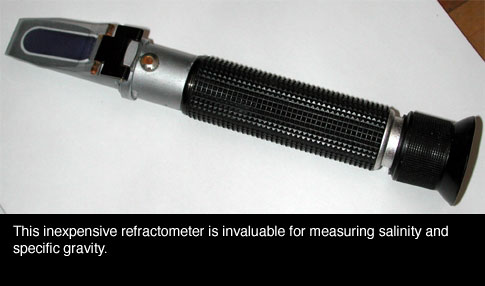 |
However, there is now a ready availability
from aquarium sources of devices called refractometers that
are generally quite accurate, easily calibrated, extremely
quick and easy to use, and inexpensive, to boot. I say this
loosely, since I regularly use a refractometer that is not
inexpensive at $280.00, but I also have one that reads identically
to it and costs $69.00. Most of the refractometers available
in the aquarium trade today are also temperature compensated
so that no special calibration is needed for temperatures
of reef aquaria. They are a lifetime investment, require little
care or maintenance, and are so easy to use that accurate
salinity measurements can be taken daily in a matter of a
few seconds. I cannot fathom any reason why any aquarist should
not have one of these devices in their aquarium repertoire.
pH Pen
Another no-brainer is the purchase of a
pH pen. During the course of only a few years with regular
testing using colorimetric reagent tests, one could have paid
for the purchase of an inexpensive "pocket" pH tester.
As with salinity, pH readings using various reagent-based
tests are variably accurate. Even though the standard reagent
pH test is one of the easier tests to perform, I think I speak
for most hobbyists when I say that getting out little bottles
and tubes is not something I want to do more often than I
have to. Although pH readings are highly variable and important,
I think its safe to assume most people would take this reading
more often if it took seconds rather than minutes.
There is a wide range in cost and quality
of devices made to measure pH. However, inexpensive pen-type
pH probes are readily available, many for under $50.00. This
is about the cost of five reagent pH tests, and the pH pen,
used properly, will last for years or decades. Their calibration
is quick and easy, and taking pH readings of tank water takes
approximately 5-10 seconds. I store a pH pen upright with
its cap filled with pH 7.0 buffer beside the tank. I remove
the cap, swish the pen in the water and take an accurate reading
within seconds, rinse the pen under tap water, put it back
in its cap, and I'm finished.
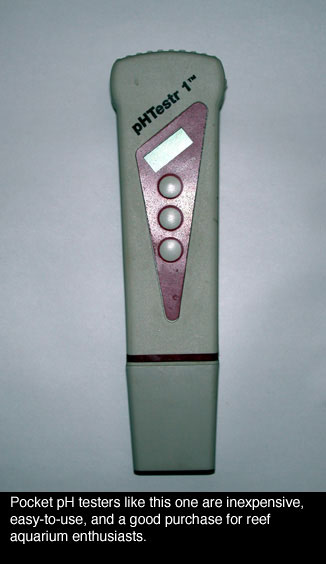 |
I had always been too lazy to sit at a
table for an hour testing various water parameters with reagent
kits in the aquarium hobby. I hate little bottles with randomly
sized drops, tiny little packets of powders that rarely all
come out of the package, tiny plastic tubes that you can't
see through in a few months, glass tubes with openings so
narrow you miss the opening with the products you try to add
to them, little stoppers that leak, color charts that do not
match the results of the test, and reagents that go old within
the time frame of my using them up. I am pleased that some
lines of tests today are more accurate than when I began testing
tank water with reagent powders and drops, but they are certainly
no less inconvenient. Consequently, I rarely tested water,
and sometimes I should have. This is more the case with the
important parameters, of which pH is one. Any inexpensive
device that saves me money in the relatively short term, provides
accurate results, lasts a long time without replacement, and
makes my aquarium maintenance life easier is a good thing.
I suspect it would be the same for most other aquarists, too.
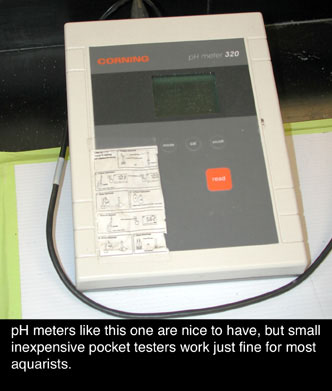 |
250, 500, 1000ml Graduated Beakers
Yes, measuring cups, bowls, glasses, and
plastic cups work just fine to make additions to tanks. However,
believe me when I say that using Pyrex beakers in these three
increments, coupled with a Sharpie pen to mark on them, will
be very appreciated when measuring, pouring, and adding any
number of dry or liquid substances to aquariums. In addition
to thanking yourself a thousand times for the many aquarium
uses found for them, the limitless other household uses will
never cease to amaze.
Magnifying Lens
If the stereo microscope mentioned above
is not an option at the present time, the use of a good quality
magnifying glass, loupe, or lens will suffice. I cannot think
of any reason why one should not have one of these for looking
in the tank, examining things after taking them out of the
tank, or for helping in identifications. The only downside
to magnifying lenses is that one can look just a little "geeky"
when observing the tank, face pressed against the glass, and
friends and family may truly begin to wonder about you. If
anyone wants to go a little more overboard, consider the purchase
of a ring-light magnifying lamp that can be purchased from
office supply stores. These can be clamped on the edge of
a tank or stand and simply swiveled to examine all creatures
great and small under lighted 10X magnification or more with
a big viewing area.
Syringes
Syringes are invaluable to reef aquarists,
if not only for their usefulness in attempts to kill Aiptasia
anemones. Unfortunately, most syringes readily available to
the public come without needles (a most useless equivalent
of a small turkey baster), or with needles that have a square
cut end that are not really made for injection (such as those
from home improvement stores). But, syringes are not illegal,
they are not by prescription only in most places (despite
what many pharmacists may tell you), and you can get them.
Insulin syringes are great. I prefer 1-3 cc syringes with
luer-lock ends where one can simply replace the needles. Luer-locks
also prevent viscous solutions or clogged needles from being
blasted off the end of the syringe and falling to the bottom
of the tank when forcefully ejecting a liquid. For assorted
gluing jobs, I use one-time-use syringes with a larger bore
needle to fill with superglue after the cap has become cemented
onto the tube following several cap re-openings, when one
cannot get the remaining glue out of the tube without tearing
the plastic cap and twisting the metal tube to some unrecognizable
and useless lump of metal with half the product still inside.
A simple prick of the tube and a pull of the plunger and I
am back in business.
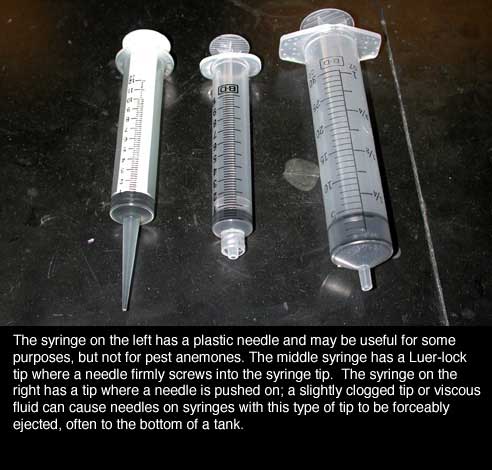 |
Yes, you might feel like a junkie asking
for them in the prescription area of a drugstore. I have bought
countless boxes and bags of insulin syringes, and felt like
Sid Vicious every time I asked for them. I tended to buy a
box at a time to avoid going through this anymore than I had
to. However, there are online and other sources for syringes
(lab supply, veterinarians, etc.) that do not involve such
situations as being asked to present diabetes cards, asking
what use you have for them (and explaining to a pharmacist
what an Aiptasia is, exactly, and how they are so evil
they must all be exterminated with hydrochloric acid), or
wearing short sleeves in the middle of winter to assure everyone
that you are not hiding track marks. Remember that the larger
the number of the needle gauge, the smaller the needle is.
For example, a 12-gauge needle is like putting a firehose
on a syringe. Fit one with a 29-gauge needle, however, and
the Aiptasia will not even notice until its mesenteries
are boiling!
Digital Camera
Without question, these are among the most
important inventions since the computer. These devices make
it possible to easily document tank events, share photos,
acquire online help, sell items, and even illustrate online
aquarium magazine articles! Best of all, it is now possible
for even rank amateurs to take really good aquarium photos
without the ridiculous amounts of special techniques that
were once required with the use of film cameras to get an
only somewhat blurry photo of one's pride and joy aquarium.
I still have quite a few film cameras - nice ones, too. They
mostly collect dust now. I like the idea of film photography,
and enjoyed doing it. But, for most purposes, I say "purist
shmurist." I'll take those 192 high-resolution clear
images on a 128MB card that costs the same as a few roles
of unprocessed Velvia any day of the week. Digital images
are easily formatted, saved, shared, shrunk, published, emailed,
printed, cropped, and Photoshopped. I have the use of an extremely
nice slide scanner at my lab, and have a darn nice scanner
in my home. It takes about 5-10 minutes to scan a single high
resolution slide that still lacks the vibrancy of a digital
photo and in no way provides what the original slide showed.
Today, I really have no use for slides whatsoever. They sit
in boxes next to my film cameras. If anyone wants to take
pictures of their aquarium, in my mind there is no substitute.
Back-Up Power Supply
See below.
Arm & Hammer Super Washing Soda and Mrs. Wage's
Pickling Lime
My calcium and alkalinity (calcium and
carbonate) products of choice. About a dollar a pound for
both, and I get them at the same grocery store where I will
buy my dinner. What more needs to be said?
Things to Measure
Aquarists tend to busy themselves testing
their water. This is a good skill to have, and although a
careful eye can often surpass the readings of water tests,
some parameters require regular monitoring. The standard series
of tests that most people perform on reef tanks seems to include
the following: ammonia, nitrite, nitrate, pH, calcium and
alkalinity. There are many other tests, and "testy"
persons may include iodine, magnesium, boron, strontium, phosphate,
and other inorganic and organic compounds in their "chemistry
duties." My feeling is that while they all may be worthwhile,
some are more valuable than others. In particular, ammonia
and nitrite, unless the tank is new or has been disturbed,
should always be unmeasurable by most test kits. I only use
these tests under unusual circumstances. Nitrate can be a
bit more problematic in tanks, especially new ones, but is
becoming less of an issue as better aquarium methods become
almost commonplace. Still, judging by many posts in The Coral
Forum, it seems most aquarists are regularly measuring these
substances, and failing to measure others.
Phosphate
Phosphate is often a problem, and has fairly
serious consequences to reef tanks in any but nearly unmeasurable
levels. I will not go into any depth on the subject since
it has been well covered elsewhere (Holmes-Farley
2002). Although many people measure it, I would estimate that
the majority of aquarists do not. In my experience, poor coral
growth, undesirable algae, and a tank that lacks vitality
is often found to have elevated phosphate levels. I would
suggest that this, or any standard water quality tests, be
used regularly, especially by those who are relatively newcomers
to reef tank husbandry.
Alkalinity
If I could name a single water quality
parameter that is observationally the best indicator of a
healthy tank, it would be alkalinity. Tanks with high alkalinity
are generally ones that are doing well. Again, the subject
of alkalinity has been treated elsewhere (Holmes-Farley
2002), and its co-function with calcium in producing the products
of calcification is well known. What is worth mentioning here
is that calcium, despite rapid depletion, is rarely limiting
to calcification in seawater because of its very high availability.
Alkalinity, however, is also rapidly depleted in tanks, and
can be limiting to calcification. I rarely test calcium because
I know from experience and my regular maintenance that I am
adding a lot of calcium and I know it is at levels that make
it readily available. I do, however, test alkalinity regularly
on many of my tanks.
Ironically, and perhaps because of its
rate of depletion in the small water volumes of aquaria, natural
seawater levels of alkalinity are, in my experience, suboptimal.
I prefer to keep my aquaria at levels much higher than seawater,
and have seen no downside to doing so. On the contrary, if
my tanks fall to seawater levels (about 2.9 meq/l), the tanks
tend to look very poorly indeed. I strive for alkalinity levels
somewhere between 4 and 5 meq/l, and the results of such elevated
levels seem to indicate that reef aquaria thrive with the
additional availability of carbonates. Furthermore, it helps
to buffer against swings in pH values.
Oxygen
In an upcoming article, I will be covering
the subject of oxygen dynamics in aquaria. Without question,
oxygen levels are critical to survival of our captive marine
species. Anyone who has experienced even a relatively brief
power outage understands how quickly animals begin to die
in stagnant tank water. Oxygen levels also drop precipitously
at night, and this is especially true with tanks that are
either densely stocked or have with poor gas exchange (for
various reasons). Yet, rare is the discussion of ways to measure
oxygen, and few aquarists I know have ever measured oxygen
in their tanks.
I use an expensive oxygen field probe,
and it would be impractical for most aquarists to own such
a device. However, oxygen probes are available to the hobby
at somewhat reasonable prices. They are not inexpensive, but
given how important oxygen is to the life in our tanks, it
seems a reasonable cost. Much more practical, if not slightly
less accurate, are colorimetric tests that are available from
many aquarium test kit manufacturers. I would suggest that
oxygen is something that should be tested for in aquaria far
more often than it is.
The Tool Shed
When one first begins keeping an aquarium,
the fish store is the source of almost all the dry goods and
equipment purchased. Over time, however, I can almost guarantee
that Home Depot or Lowe's purchases will exceed those spent
at fish stores, except perhaps on livestock. This section
is truly the insider's guide. Trust me when I say that these
things will be used, will come in handy, or will almost without
exception be required at some point during the lifetime of
a reef aquarium.
Plumbing
-
PVC pipe and various fittings, including
elbows, couplings, male adaptors, barbed fittings, and
female adaptors. At least five of each type, both slip
and threaded, in all the common pipe sizes of 1/2",
3/4", 1" 1.25", 1.5" and 2" should
be kept on hand at all times. Also, one full length of
each of the pipe sizes should be on hand.
-
a PVC cutter and a hacksaw for the
larger sized pipe
-
an eight foot length of flexible vinyl
tubing in every size from airline to 1" inside diameter
(and stainless steel or plastic hose clamps to fit the
tubing).
Adhesives
Electrical
-
wire strippers
-
wire nuts - a box of each of several
sizes
-
electrical tape - numerous rolls
-
cable ties (lots of these, in different
sizes)
-
coax staples for tacking up cords
-
power strips and extension cords (at
least five of each)
-
ground fault interrupting outlets if
not already in place
Tools
-
stainless steel wire cutters. Do not
even bother to spend the money on steel ones. They will
rust after one or two uses to the point where they cannot
be opened, and you cannot put oil on them to free them
up because the oil gets in the tank.
-
small wood chisels
-
Dremel-type tool with various cutting
blades
-
hole saw kit with various size hole
saws
-
acrylic cutter for scoring plastic
or an acrylic blade for a table saw, Dremel tool, or jigsaw
-
single-edge razor blades (a 100 count
box is the best idea)
-
some form of power screwdriver
Materials
-
several sheets of eggcrate
-
fishing line
-
a 2' x 4' sheet of at least 1/4"
Plexiglas or acrylic
-
an assortment of nylon and stainless
steel nuts, washers, and machine screws
-
plastic scrubbers for dishes
-
various sizes of Tupperware-type containers
-
several Rubbermaid-type bins, at least
20 gallons in size
-
pint, quart and gallon containers or
bottles
-
Ziploc-type freezer bags in quart and
gallon size
-
rubber bands
-
Sharpie permanent markers
Little Things
The following is a list of little truisms
I have found to apply quite often in reef aquarium husbandry.
I think they will prove useful many times over lengthy periods
of time.
When in doubt, do a water change - or two.
Then, watch and wait.
Have a functioning and functional quarantine
tank for all newly acquired livestock, and for established
livestock with problems that need attention.
Algae and cyanobacteria happen, even under
ideal conditions. If nutrients are low, and grazers are adequate,
algae still happens sometimes. They can also go away as fast
as they came, and sometimes waiting is better than intervening.
When confronting things that are not recognized,
it's probably best to figure out what they are before deciding
that they are bad and destroying them.
Aiptasia anemones are really horrible
pests. They are the poster children for why quarantine is
so important. I have, since beginning my first reef tank,
been plagued with them and they have killed, or caused me
to kill in my efforts to get rid of them, hundreds of corals
and other organisms. I have spent hundreds of hours and hundreds
of dollars fighting them. I have succeeded three times in
eliminating them from my tank by various means. Each time,
I have inadvertently reintroduced them. If you have them,
good luck. If you see one, kill it thoroughly or (and I am
not joking) get rid of whatever it is on. Just throw it out
- the rock, the coral, or whatever. If you do not have them,
I would strongly suggest quarantining EVERYTHING to avoid
getting them. I reintroduced them on pieces of algae once!
The pedal lacerates can be very small and not even visible,
but will be noticeable within a month. I cannot stress enough
how much everyone wants to avoid having these anemones in
their tank.
Keep your hands out of the tank as much
as possible, and resist the temptation to move things or add
things any more than is absolutely necessary. It's best for
reef aquaria to be left alone as much as possible.
Spend as much time watching and growing
and reproducing things, and spend as little time buying things,
as possible.
Don't place too much faith in what the
majority of the aquarium hobby has to say! Just listen, smile
a lot, and make sure what you have heard or read is the truth
(see Shimek
2003 and Borneman
2003).
Nothing speaks quite like experience,
although experience gained through advanced learning and planning
is a good thing.
For persons about to purchase their first
tank, get one at least twice as big as the one you are considering.
Only when you are really proficient will the idea of a small
tank be a reasonable and practical endeavor.
I'm not a big fan of aquarium equipment,
in general. However, there are two things that should not
be compromised, and they are both expensive items and important
items. Believe me when I say that every ounce of pain that
comes from emptying a wallet on good pumps and good lighting
will be the reason for a sigh of relief many times over.
Aquarium Products
I rarely endorse products. In fact, I have
made it a practice to avoid any sort of product endorsements,
and my nearly constant deriding of such things for the past
decade has probably resulted in my being permanently blackballed
from the good graces of many companies who would otherwise
be sending me free products and reimbursement for my marketing
prostitution. Nonetheless, I don't care and I never have.
I really couldn't even begin to say how many different devices
and products I have bought or tried over the years. So here,
for perhaps the first time ever, I am going out on a proverbial
limb and giving a thumbs-up to the following products that
I have used for enough time and for many times and I think
deserve credit where credit is due. I offer my apologies to
those not mentioned, but it is not possible to try, use, or
know every product available.
Similarly, I refuse to mention those many
products that deserve a "Golden Garbage Pail" award.
Be warned: this is a short list.
Aquarium Systems MaxiJet Powerheads
These things "take a licking and keep
on ticking." I have some of my first powerheads that
still run, despite my splicing on new plugs where I melted
them in wet power strips. Sometimes you have to smack them
to get them to run, the impellers sometimes shear and need
replacing, and the suction cups….well, they suck! They
deteriorate fairly quickly in seawater (but, so do all the
other brands, and usually faster). Some of my first Hagen
powerheads still run, too, but their flow rate for unit size
is awful (though adjustable flow control is nice). But, in
my experience with (I think) multiple kinds of every power
head made over the past decade or so, these are the best and
always have been. A few little fixes (hint, hint) and they
would be nearly perfect, for what they are.
Tunze Stream Pumps
I hesitate to mention these, since they
are relatively new, and I have only used a few of them. I
am deeply disturbed by their cost, and absolutely stunned
at the cheapness of the materials and mounting devices. Still,
to use the vernacular, "these pumps rock." The water
flow is stunning, pump efficiency is beyond anything else
available, and they have run constantly despite my intentional
and unrelenting abuse. One stopped working briefly until I
dissolved the heavy calcium deposits from around the magnet
assembly. Several months ago, I even broke one of the cheap
plastic pieces, and lost an o-ring from, well, somewhere,
but I plugged it back it and it ran like a charm. These pumps
represent one of the major triumphs of water flow issues since
I began keeping reef tanks.
Cyclop-Eeze©
and Golden Pearls
Never before have there existed such excellent
plankton substitutes for small mouths. Subjectively, there
is no single product I have used that appears to have provided
such dramatic results.
Protein Skimmers from My Reef Creations™
The cost of good protein skimmers is an
abomination. The idea of most aquarists spending upwards of
$750 or more on a piece of plastic through which air and water
move is unthinkable to me. I have found the quality and performance
of skimmers from this company to equal or surpass those of
the "name brands." While not cheap, they are a veritable
bargain by comparison.
Livestock from Tropicorium, ORA, and Inland Aquatics
Livestock from these places doesn't die
without a lot of assistance from an aquarist. I won't go into
the many reasons why this is probably the case, but a lot
stems from the care and expertise of the owners and staff.
Order accuracy, availability, color, selection, price, and
eccentricities aside, in my mind the aquarist could do no
better in their choice of a livestock supplier based on standards
of health, survivability, and ethics than those listed above.
Emergency Readiness
It is only a matter of time before an aquarist
faces some sort of accidental disaster. Such events seem to
happen more frequently when one is not at home, of course.
I have personally had massive tank disasters happen more than
I care to admit. Some of them were unavoidable, others were
not. Each time, after ameliorating further losses and restabilizing
the tank, I took various steps to ensure that another similar
event did not occur. Unfortunately, all too often I used a
"bandage and a prayer" rather than truly taking
steps to prevent future problems, and predictably, I incurred
further losses at various times afterwards.
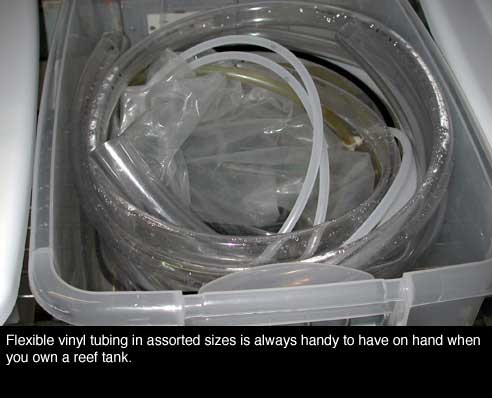 |
I can't express how heartbreaking it is
to lose animals nurtured for many years, and this is doubly
so when the reason for their death lies squarely in one's
own hands. The financial losses alone can be extraordinary,
the time spent growing or breeding or caring for various species
is lost forever, and the loss of life is tragic. I would add
that in my own case, and with most events I hear about, power
failures are the most common reason massive aquarium losses
occur. It is nearly impossible to ever be prepared for every
contingency, but given the most likely scenarios, I would
suggest the following:
|
Keep
the following extra items on hand, beyond what is immediately
being used:
|
Extra salt
|
- at least enough to prepare
the same amount of water as the volume of all
tanks in the house.
|
|
Medication
|
- I try to keep a broad-spectrum
antibiotic, medicated foods, Lugol's iodine solution,
and "Liquid Bandage" on my aquarium
shelves for those fortunately rare cases where
their use is warranted.
|
|
Water
|
- I would suggest keeping at
least ten gallons of clean freshwater available
at all times. The numbers of times I have quickly
had to use at least this water volume for one
reason or another are uncountable. Were I to have
waited for an RO unit to produce this volume,
or had to go to the store and purchase water,
serious losses could have occurred.
|
|
Containers
|
- I would store at least enough
plastic bins or tanks to house every organism
in the tank, even if extremely crowded, for a
few days.
|
|
Pumps
|
- An extra submersible pump
capable of turning over the water in the tank
in the event of failure of the main pump is a
very wise idea. I've found that having an identical,
back-up main pump is also good planning. In addition,
at least one powerhead should be dedicated for
each of the bins or containers mentioned above.
I would also keep one extra impeller for each
pump or powerhead in the tank. In most cases,
tank inhabitants can be kept alive for many days
or even weeks in just circulating (and heated)
seawater, with no lights or filtration.
|
|
Lights
|
- I would keep at least enough
used bulbs, extra bulbs, or extra fixtures on
hand to provide a reasonable amount of light in
the event of bulb or ballast failure. Providing
light is less critical in the short term, but
I also realize that many times it takes longer
than expected to get replacements for specialty
aquarium fixtures, during which time the tank
can become unnecessarily compromised.
|
|
Heaters
|
- I am fortunate to live in
an area where heating tank water is rarely something
that needs to be done. However, I was reminded
by our editor that many poor souls live where
it physically hurts to go outside in the winter.
I don't know why anyone chooses to live where
eighteen layers of clothing must be worn, or where
it takes personal and city-wide effort to remove
snow and ice to walk or drive, but nonetheless
it seems they do. In such cases, reef aquaria
are under some threat from these elements, and
a back-up heater is an excellent plan to avoid
frozen fish and corals. In addition, heaters in
the aquarium hobby tend to be rather flimsy, in
particular the glass ones. I think the availability
of the titanium heaters in the trade, in addition
to inline heaters (expensive), are probably the
wisest puchase in terms of reliability and safety
to ones' tank and oneself.
|
|
Back-up Power
|
- There are many ways to provide
back-up power, and the subject has been written
about elsewhere (Trevor-Jones).
This is, however, the most critical piece
of emergency equipment. Among the many options
are generators, solar cells, UPC devices, battery
powered equipment, and car battery power inverters.
Included with any of these devices are the required
power strips and extension cords needed to get
power to the tank. It is not important to power
everything in the tank, but it is essential to
have a source of back-up power able to run at
least a main pump or enough powerheads to keep
the tank water circulating well.
|
|
Support Group
|
- Finally, making sure that
there are people available and within contact
to help or tend to an aquarium in the event of
a problem is literally a lifesaver. Aquarium clubs
provide ample opportunities to make such connections.
|
|
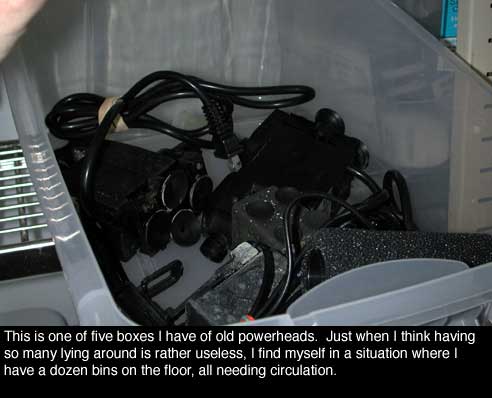 |
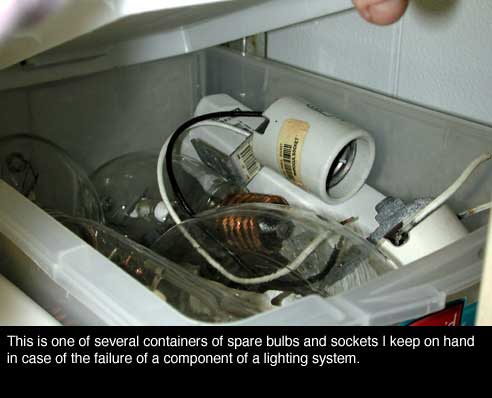 |
Conclusion
As is usually the case, I
finish an article only at a semi-random point or arbitrary
determination when I think I have written enough. There is
really no way to exhaustively cover all the little things
that are the product of years of experience. I find myself
concerned that through some omission here I will indirectly
cause the death of someone's livestock. I do sincerely hope
that the information here will be of use to those who have
not thought of such things, or have not yet had the opportunity
to do so. I also encourage others to visit my forum
on ReefKeeping to add their input and opinions to this
short "Insider's Guide" to Reef Aquaria.
|

